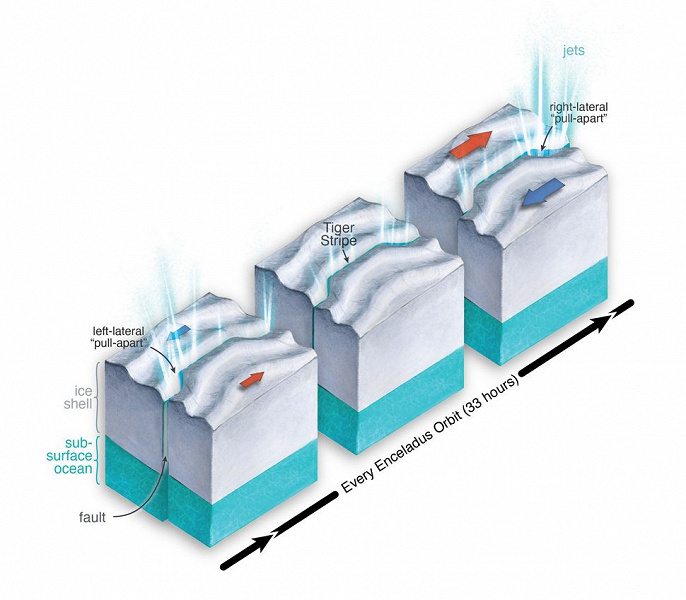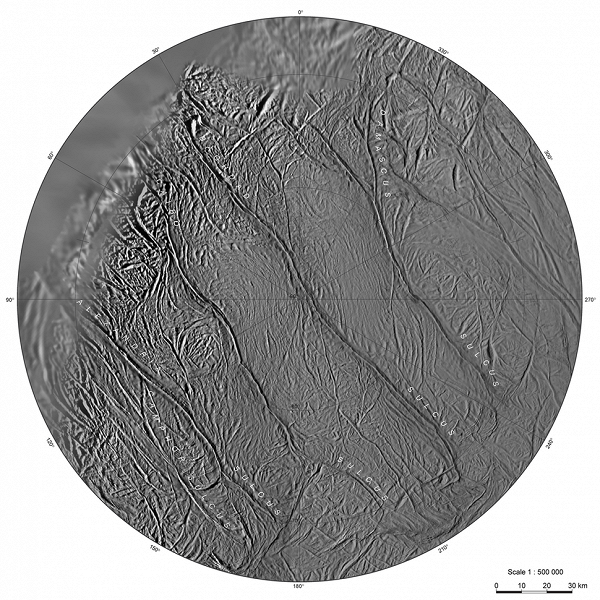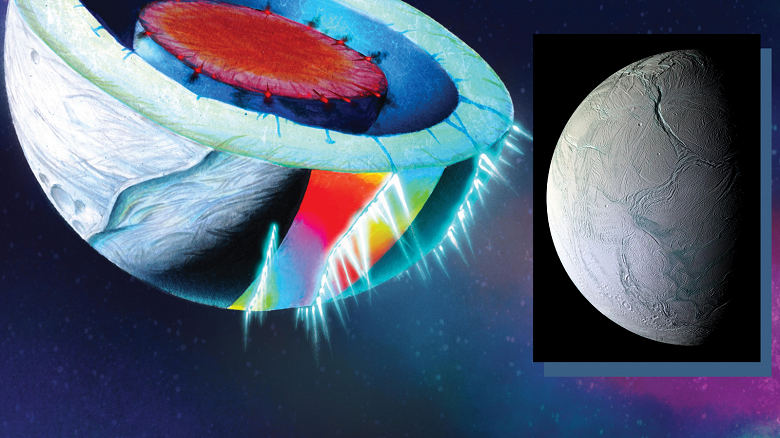Saturn's tidal forces, friction, and fault movements control the release of water from Enceladus
Recent research has shed light on one of the biggest mysteries of the solar system — unusual «tiger stripes» at the south pole of Enceladus, a moon of Saturn. Scientists have discovered that sliding along these characteristic fault lines is associated with powerful jets of ice crystals escaping from the moon's icy shell. These results may help determine whether Enceladus's subsurface ocean is favorable for the emergence of life.
“Tiger stripes”, consisting of four parallel cracks, were first noticed by NASA's Cassini spacecraft. in 2005. Powerful jets of ice erupt from these faults, indicating so-called «cryovolcanism» — analogous to volcanic activity, but with the participation of water and ice instead of molten lava. Scientists suggest that these jets originate from the subglacial ocean of Enceladus.
The brightness of the ice crystal plume and the intensity of the jets themselves change cyclically in accordance with Enceladus's nearly 33-hour orbit around Saturn. This led researchers to suggest that the activity of the jets is enhanced by tidal forces caused by the gravitational influence of the planet.
However, this theory could not explain some observed features, such as the peak in jet brightness occurring several hours after maximum tidal load, or the presence of a second, smaller peak appearing shortly after Enceladus' closest approach to Saturn.
To resolve this contradiction, a group of scientists led by Alexander Berne from the California Institute of Technology developed a complex model that takes into account the interaction of tidal forces and movement along tiger cracks. «These models take into account the role of friction, due to which the magnitude of displacement along faults becomes sensitive to both compressive and shear stresses», — Bern explained.
Modeling results showed that friction controls movement along the boundaries of tiger faults where their opposite sides meet. During the orbital cycle of Enceladus, these stripes periodically «slide» and cling to each other. It is this lateral displacement that coincides with the activity of cryovolcanic jets.

The team further hypothesized that changes in jet activity are controlled by the presence of so-called «ruptures» along faults — curved sections that open under wide shifts. This allows water from the subglacial ocean to seep through the icy crust and fuel powerful cryovolcanic eruptions.
The team's opening reveals that «tiger stripes» Enceladus is being discovered differently than previously thought. «This was a surprise, since most previous studies have considered the wide opening of these cracks as the main mechanism regulating changes in the brightness of the ice crystal plume, similar to the opening and closing of elevator doors»,— explained Alexander Bern.
According to the Koltech researcher, their models suggest that tidal forces play a fundamental role in the evolution of Enceladus and its subsurface ocean on different time scales. «On the scale of a single orbital period, tides appear to regulate the amount of material flowing out of the subglacial ocean through faults. And over longer time periods, they can lead to the destruction of these friction strips themselves», — noted the scientist.
Byrne suggested that long-term lateral movement of fractures may contribute to the formation of the unusual geological formations observed around Enceladus's south pole, including a large rift diverging from this region in the moon's opposite hemisphere.

Scientists believe that Enceladus, with its subglacial ocean, could become one of the main targets for the search for extraterrestrial life in the solar system. Bern's team's new research and model strengthens this hypothesis. «Understanding how materials are transported through fracture zones or wide cracks is critical to determining whether the ice crystals in Enceladus' plumes are representative of that moon's potentially habitable global ocean», — explained the scientist.
He added that evidence of the long-term influence of tides on the evolution of Enceladus, which also warms its interior, implies that the moon's subglacial ocean is long-lived, which has important implications for the possible evolution of life there.
Currently, the command's output is based on computer simulations and must be confirmed by actual observations. », —Geophysical measurements on Enceladus using radar would allow us to confirm or refute the hypotheses set forth in our article. More broadly, such observations of Enceladus's surface motion over time could provide key constraints on the dynamics of its core and crust, and how active these processes have been over time. “We are committed to continuing to explore geophysical measurement techniques to better understand the conditions that may allow life to originate and evolve on Enceladus,” Bern concluded. >

